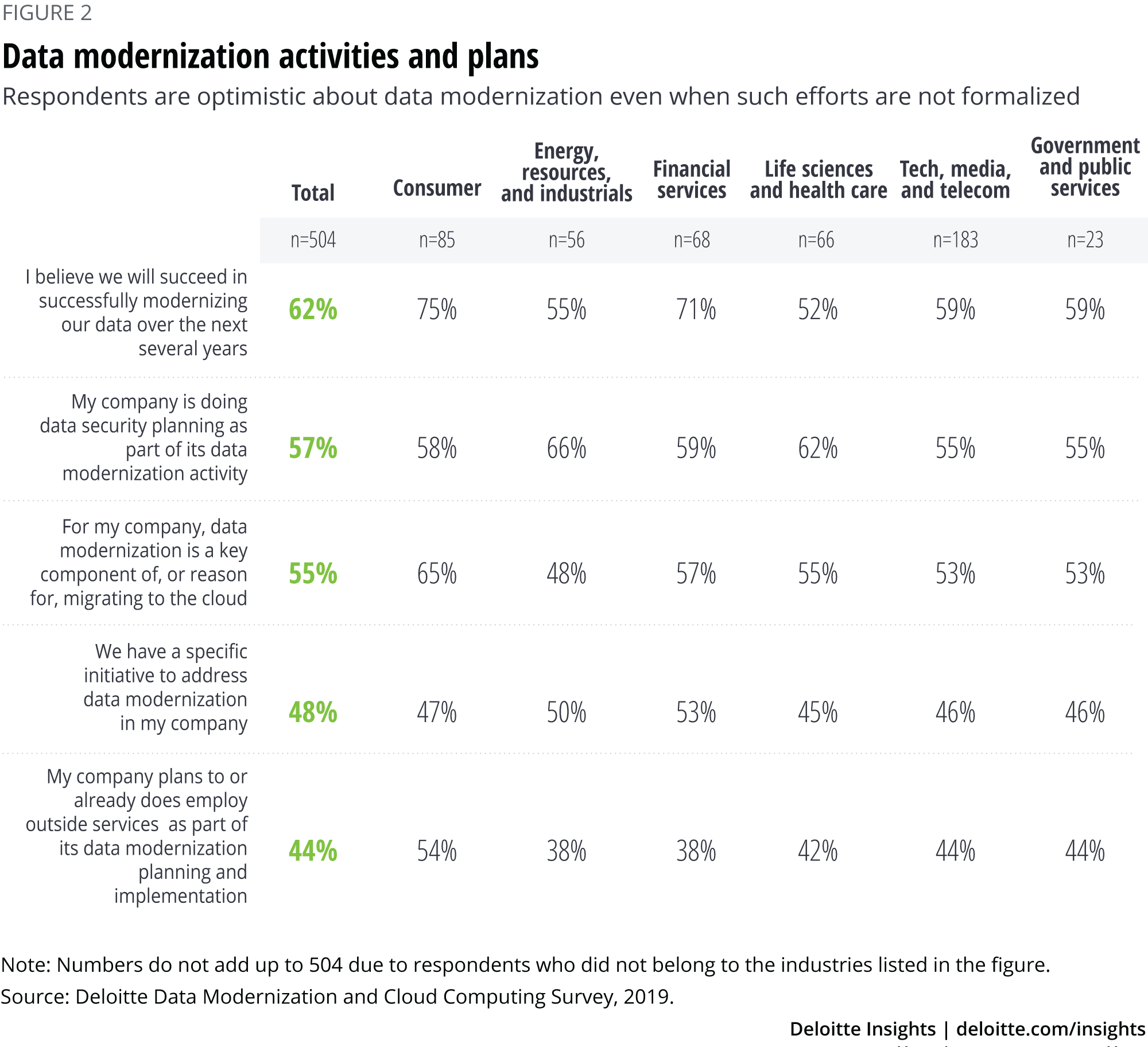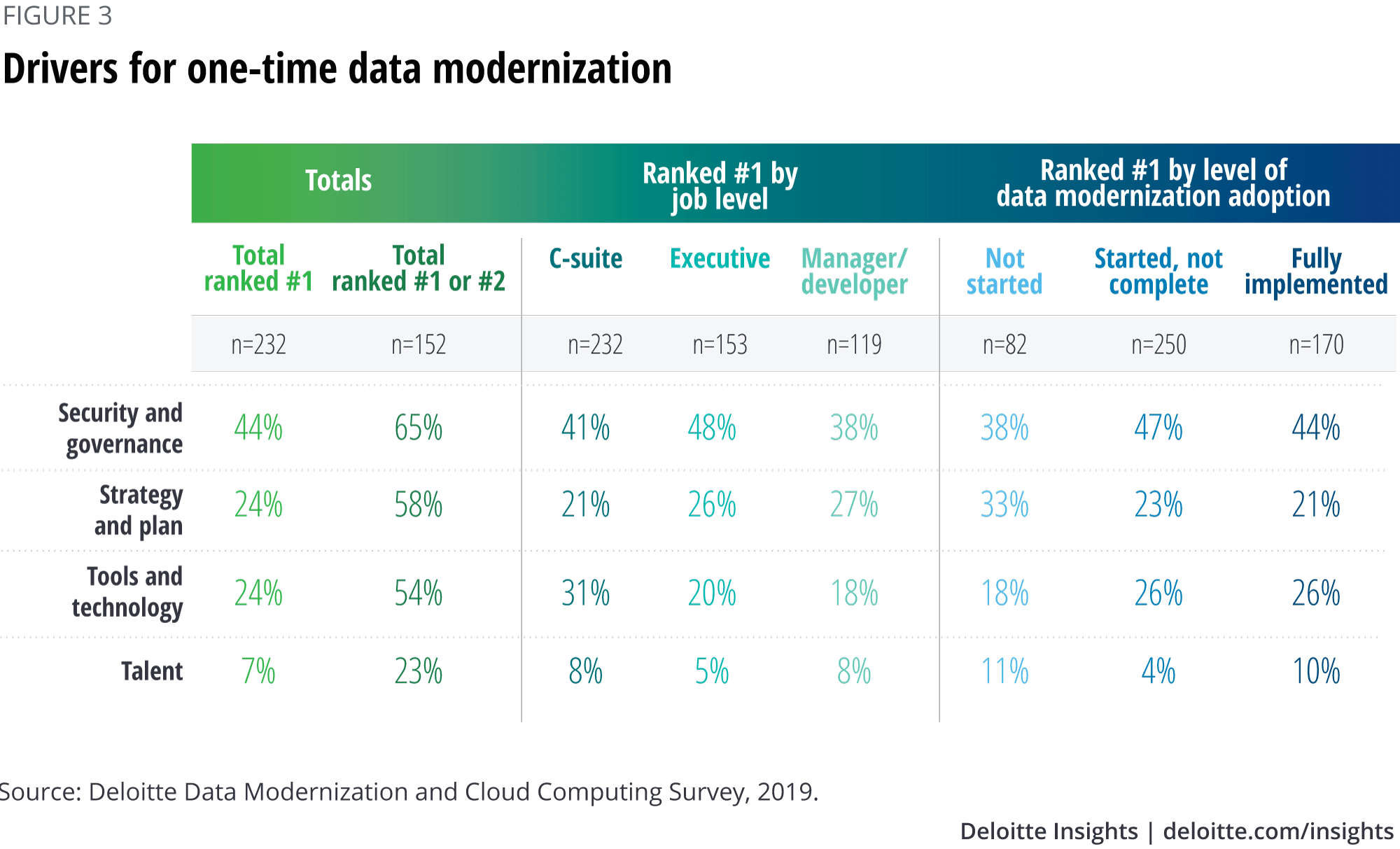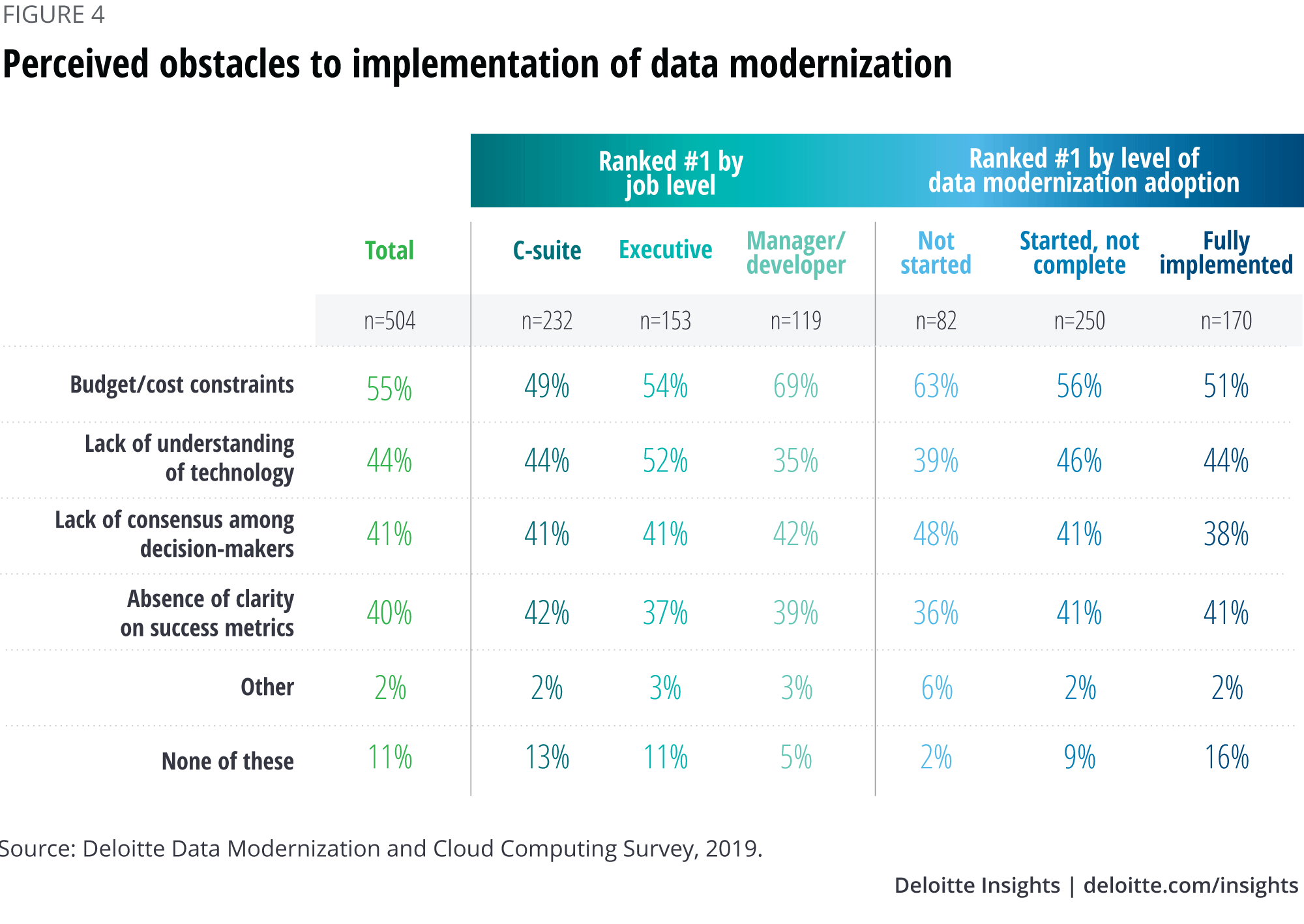
Data modernization and the cloud Which trend is driving the other?
8 minute read
26 August 2019
Many US companies are moving data to the cloud, and while doing so, they prefer modernized platforms. This begets the question—is data modernization driving cloud adoption, or vice versa?
Two of the most dramatic changes in contemporary information technology (IT) architectures are the rise of the cloud for processing and storing data, and the modernization of data management tools to accommodate unstructured data and open-source technologies. These two trends are happening simultaneously, but their relationship is unclear. Both are critical to success for today’s organizations, but which drives the other?
Learn More
Explore the Digital transformation collection
Visit the Analytics collection
Subscribe to receive related content
Download the Deloitte Insights and Dow Jones app
It is, of course, always difficult to establish causal relationships among trends, but results of our recent survey (see sidebar, “Survey methodology”) reveal that these two developments are reinforcing each other. On the vendor side, cloud providers are offering not only cloud-based storage and processing, but data modernization capabilities as well. On the user side, many leading firms are doubling their data footprints once or twice each year, so they are looking to simultaneously reduce costs, take advantage of new forms of big data, get greater flexibility in analyzing data, and employ powerful artificial intelligence (AI) and analytics algorithms. These benefits are available to firms that modernize their data and move to the cloud at the same time.
Survey methodology
In April 2019, we conducted a survey of 504 respondents in the United States, all of whom work in IT groups of medium to large companies. These companies have annual revenues in excess of US$500 million and 60 percent have revenues of more than US$1 billion. In terms of respondents’ levels, 46 percent are C-suite executives, 30 percent senior executives/head of business units, and 24 percent managers or programmers. All respondents reported being involved in or making decisions about cloud and/or data management issues.
What is data modernization?
Simply put, data modernization means moving data from legacy databases to modern databases. It is particularly critical for any organization that needs to store unstructured data—images, customer voice audio, social media comments, clinical notes in health care, and so forth. Data modernization offers substantial cost advantages over previously used data management technologies.
Over several years, many large organizations have shifted from a data architecture based on relational enterprise data warehouses to data lakes based on Hadoop and other open-source tools.1 However, they may not have eliminated warehouses completely—warehouses are still useful for many applications involving structured data—but these companies are deploying modernized platforms for many new business applications.
How prevalent is data modernization? Very much, indeed. Our survey results reveal that the companies we surveyed are already well along in the process of data modernization, with the great majority (84 percent) having already started their journeys toward that goal. Around one-third (34 percent) claim to have such initiatives fully implemented, while half have data modernization initiatives underway (figure 1). Financial services firms are the most likely to have initiated data modernization. Somewhat surprisingly, technology, media, and telecom firms are the least likely to have started down the path, despite the technical orientation of their products and services. Even then, 81 percent respondents from the sector report having begun modernization initiatives.

While the majority of respondents (62 percent) expect to succeed in their data modernization efforts, such initiatives are not always formalized (figure 2). Less than half (48 percent) of respondents say they have a specific, formal initiative for data modernization, but many others are modernizing their data storage anyway. Interestingly, the majority of respondents—57 percent—report that they are doing data security planning as part of their data modernization activity, and “data modernization” may even be the primary banner under which they will describe it (figure 3). Respondent companies are cognizant of the real-world needs of their businesses and consider the tools and technology that are available in the marketplace the third most important reason in their decision-making.


Although there is clearly progress on data modernization, it is not without obstacles (figure 4). The most common obstacle cited by respondents is “budget/cost concerns overall” (55 percent). The other factors include the lack of understanding of technology (44 percent), the lack of consensus among decision-makers (41 percent), and the absence of clarity on success metrics (40 percent).

What role does the cloud play?
The cloud is both a means to and an important consequence of data modernization. Survey responses indicate that the cloud is already a dominant location for data storage—more than nine in 10 organizations (91 percent) primarily keep their data on cloud platforms. Of the remaining nine percent that primarily keep their data on premise, nearly all plan to migrate to the cloud. What’s more, on average, 57 percent of the surveyed organizations’ businesses are actually operating on the cloud—meaning that all their important applications and data are on it. That’s saying a lot, since many organizations—including the financial services firms in the survey—often have to keep some applications and data on premise for regulatory reasons.
It is possible to pursue only on-premise modernization projects, but given that many firms are moving data to the cloud, they often put it on modernized platforms at the same time. This makes the cloud a non-negotiable part of data modernization. The cloud/modernization connection is strongly apparent to survey respondents (figure 5)—55 percent see data modernization as a key component of or reason for cloud migration. It is second only to security and data protection. The C-level respondents actually rank it the highest as a rationale, with 65 percent overall saying it is a driver of cloud migration.

There are many other reasons for moving to the cloud. Traditional IT architectures and on-premise data centers often come with their own cost concerns, which make cost a key driver of cloud migration. In the survey, 32 percent identified the “general cost and performance of IT operations” as the top-most or second driver for moving to the cloud. Middle-level executives were most worried about this issue, C-level executives somewhat less so. Since companies expect to save money by migrating to the cloud, they could perhaps mitigate some of their concerns about the cost of data modernization by leveraging cloud migration as the primary means to modernize. Other drivers are the availability of cloud-based software and access to external data.
Many companies are discovering that the core capabilities of understanding customer journeys, making “next best offers,” and monitoring customer experiences are difficult or even impossible to achieve with a traditional premise-based analytics footprint. Cloud providers typically have strong capabilities in data management—even including relational data warehouses in the cloud—as well as high-quality algorithms for analytics and AI, and a wide range of external data sources.2 As such, most cloud providers enable companies to achieve more than on-premise capabilities.
Cloud and data modernization initiatives: How they helped companies improve performance
Several companies have combined cloud migration and data modernization to deliver on their strategic goals. Given below are some examples of how these initiatives have panned out.
- A large rental car company in the United States is making large investments in both cloud and data modernization as part of a general updating of its technology infrastructure. It outsourced operations of legacy systems and is moving all new applications such as digital, customer relationship management, accounting, reservations, and rentals to the cloud. At the same time, they are building a next-generation data platform to support analytics and reporting. This platform is the long-term foundation for employing cloud-based AI-based algorithms for a “constant management program” combining fleet and demand forecasting.
- 24 Hour Fitness, a US-based fitness industry pioneer with over 440 clubs nationwide and nearly four million members, realized the need to offer members more personalized offers, with customized pricing and contracts, but its premise-based data architecture was unable to do that. Therefore, the company moved its key data to a cloud-based data lake and data warehouse. Now, its data is refreshed 40 percent faster, and data from nine different sources flows into a single cloud repository. 24 Hour Fitness also adopted new cloud-based applications. Both transactional and analytical systems are able to provide the needed customization and are always up to date. In the words of the firm’s president, it can now provide “mass consumer personalization that scales.”3
These companies are examples of rapid advancement on both cloud migration and data modernization dimensions. Cloud migration and data modernization can help solve complex business and information challenges, including personalization of customer information and predictive analytics for operations.
In conclusion: Cloud migration and data modernization go hand in hand
While no survey can identify the next trend in IT and information management, results of our current survey confirm the direction and strength of the existing trends—almost all data management approaches will likely eventually be modernized and almost all data and applications will be in the cloud. Survey results confirm that both cloud migration and data modernization initiatives are well underway in most medium to large organizations in the United States, and both initiatives—whether formalized at the corporate level—are generally successful.
Notably, cloud migration and data modernization are mutually reinforcing trends—they seem to support and overlap each other.
As such, most companies would do well to embrace both trends. If factors within your organization are aligned to only one, then perhaps you can pursue a stealth strategy that also embraces the other. If you are moving to the cloud, consider adopting some data modernization approaches too. If your primary need is to modernize data, you can do that most effectively in conjunction with cloud migration. Since the two trends are overlapping, a “two for one” strategy is eminently reasonable.
© 2021. See Terms of Use for more information.
Explore the Analytics collection
-
How analytics and AI-driven enterprises thrive Article5 years ago
-
Predictive analytics in health care Article5 years ago
-
Infusing data analytics and AI Article5 years ago
-
Automated machine learning and the democratization of insights Article6 years ago
-
How third-party information can enhance data analytics Article6 years ago
-
Anticipatory government Article5 years ago
















